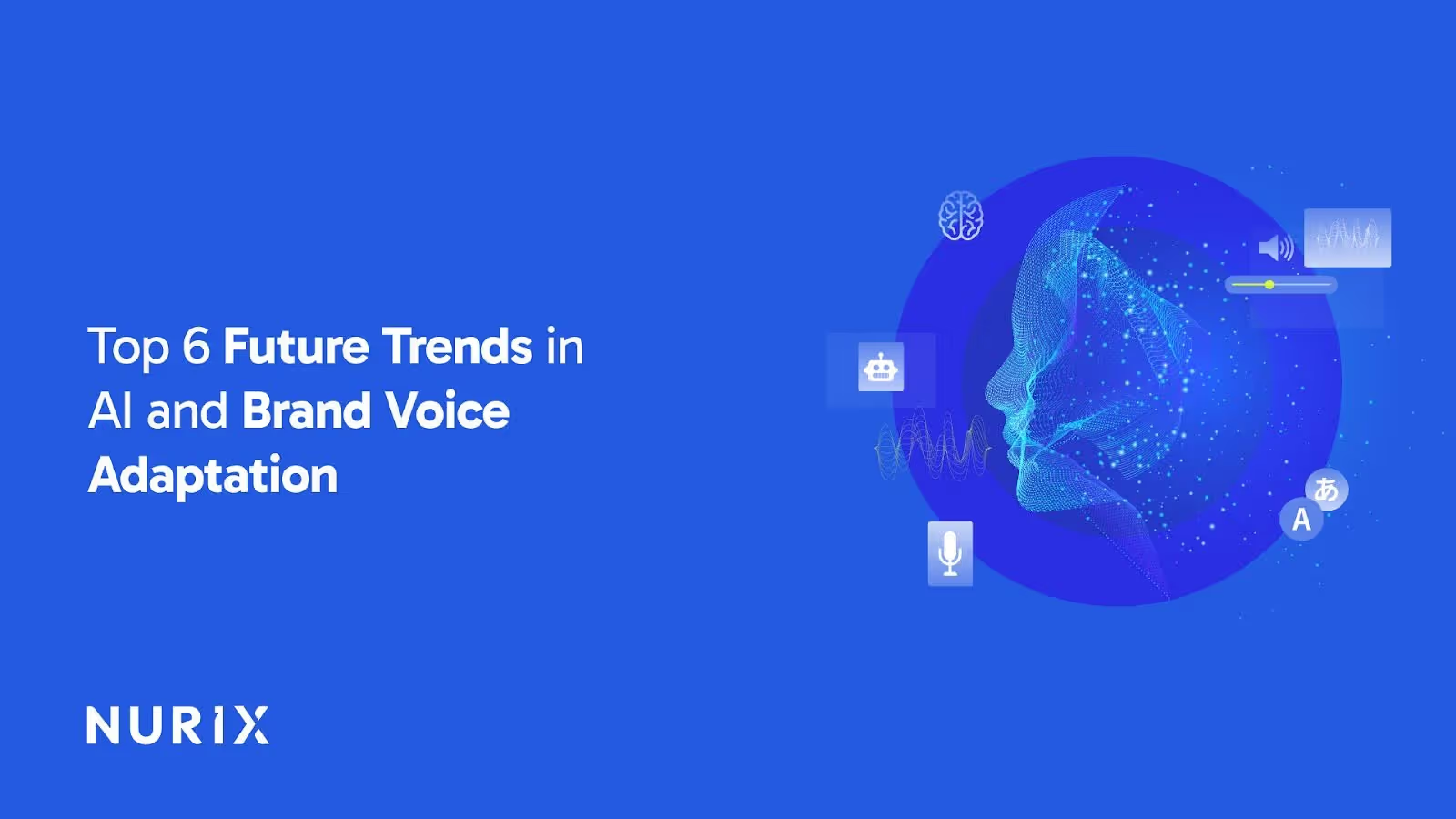When brand messages don’t quite land the way they should, it can leave people feeling disconnected. Getting the tone right across different platforms and audiences isn’t easy, and brands risk sounding off-key or inconsistent. This problem of keeping a clear, true voice going is something many face as communications multiply.
New tools powered by AI, like Nurix AI, are starting to change how brands hold onto their unique character. Instead of relying on fixed scripts, these systems can adjust the voice in real time to better fit the moment and the person listening. This makes conversations feel more natural and connected without losing what makes a brand recognizable.
In this guide, the focus is on where AI-driven brand voice adaptation is headed next. It looks at fresh ways AI is helping brands speak in many languages, use different media, and respond with context, laying out what’s likely to matter as this field grows.
Takeaways
- Emotional Nuance Matters More Than Tone Alone: AI is advancing beyond simple voice matching to detect and express subtle emotional cues, enabling brands to connect on a more authentic level.
- Language Authenticity Drives Trust: Multilingual AI systems now preserve cultural context and idiomatic expression, avoiding robotic translations and keeping brand voices genuine globally.
- Human Guidance Remains Essential: Combining AI efficiency with human oversight keeps brand voice authentic, balancing automation with empathy and complex judgment.
- Channel-Specific Voice Adaptation: AI customizes the style and formality of brand voice automatically across platforms, from social media to support calls, ensuring relevant communication everywhere.
- Scalability Meets Personalization: AI enables personalized interactions at scale, delivering millions of individual customer experiences without compromising brand consistency.
What Are AI-driven Brand Voices?
AI-driven Brand Voices use artificial intelligence to create and maintain a brand’s unique way of speaking and writing. They help businesses produce consistent messaging at scale while adapting tone to fit different contexts. This means faster content creation, uniform communication across platforms, and a more recognizable presence without losing the brand’s character.
Though AI speeds up the process, combining it with human judgment keeps the voice authentic and relatable. This blend supports stronger connections with audiences and builds trust by delivering consistent, clear brand expression.
Why Every Business Should Define Its Own AI Brand Voice
Defining a unique AI brand voice is what gives a business personality beyond products or services. It creates a thread that ties every interaction together, making communications feel intentional and relatable. Here’s why this focus on voice makes a significant difference:
- Clear Brand Identity: Defining a distinct AI brand voice helps businesses communicate their values and personality consistently, making the brand instantly recognizable and memorable to customers.
- Consistency Across Channels: It keeps the tone and messaging uniform across marketing, customer service, and digital platforms, preventing mixed signals and building trust over time.
- Better Customer Connection: A defined voice conveys empathy and authenticity, fostering stronger emotional ties with the audience and making interactions feel personal and genuine.
- Scalability Without Sacrificing Identity: As content needs grow, having a set AI voice allows for large-scale communication without losing the brand’s unique style or sounding generic.
- Time and Resource Savings: By aligning AI tools to a specific voice, businesses cut down the hours spent editing or rewriting content to fit brand standards, making workflows smoother.
- Adaptability Without Losing Core Tone: A clear AI brand voice can flex subtly for different contexts or audiences, maintaining relevance while always sounding like the same trusted brand.
- Competitive Differentiation: A unique voice distinguishes a business in crowded markets, helping it stand out by emphasizing what makes the brand feel authentic and relatable.
Advances in AI brand voice are already shaping tangible applications seen in various industries today.
Want to know about the shift from typing to smooth voice-driven communication? Explore more in Using Voice to Chat and Send Messages.
Future Trends in AI and Brand Voice Adaptation
AI is changing how brands express themselves, moving toward conversations that respond naturally to people’s emotions and needs. This evolution allows brands to maintain their identity while adapting to individual experiences and contexts. Here are the main trends driving this shift in brand voice:
1. Real-Time Conversational Brand Interactions
AI systems move beyond scripted responses to authentic, context-aware conversations that adapt dynamically to customer emotions and needs.
Key Details:
- Emotional Recognition: AI detects frustration or customer satisfaction through voice patterns and adjusts tone immediately to provide empathetic responses.
- Predictive Engagement: Systems anticipate customer needs before they're expressed, initiating relevant conversations based on behavioral patterns and real-time data.
- Contextual Adaptation: Brand voice shifts appropriately based on customer history, current situation, and emotional state while maintaining core identity.
2. Autonomous Brand Communication Agents
Independent AI systems manage entire customer communication workflows with minimal human oversight while preserving authentic brand personality.
Key Details:
- Self-Managing Systems: Autonomous agents handle complex multi-step communications from initial contact through resolution without human intervention.
- Brand DNA Integration: AI systems learn and apply specific brand voice characteristics across all touchpoints automatically.
- Continuous Learning: Agents improve brand voice consistency by analyzing successful interactions and adapting communication strategies in real-time.
3. Hyper-Personalized Brand Voice Scaling
AI creates individualized brand experiences for each customer while maintaining consistent core messaging across millions of interactions simultaneously.
Key Details:
- Individual Voice Customization: Each customer receives brand communications specifically adapted to their preferences, history, and context.
- Market Growth Acceleration: The hyper-personalization market reached $21.2 billion in 2024 and is projects to $67.9 billion by 2031 with 18.1% annual growth.
- Revenue Impact Metrics: AI-driven personalization shows a 35% increase in purchase frequency and a 21% boost in average order value when properly implemented.
4. Multimodal Brand Experience Integration
Brand voice expands beyond text and speech to incorporate visual, audio, and interactive elements in unified communication experiences.
Key Details:
- Cross-Modal Consistency: AI maintains brand personality across voice, visual, and interactive channels simultaneously.
- Sensory Brand Integration: Systems combine text, images, voice, and gesture recognition to create comprehensive brand experiences.
- Real-Time Optimization: AI adjusts brand presentation across all modalities based on customer engagement patterns and environmental context.
5. Predictive Brand Voice Evolution
AI systems anticipate market shifts and automatically adapt brand voice strategies before changes become necessary.
Key Details:
- Behavioral Forecasting: Systems analyze customer behavior patterns to predict when brand voice adjustments will be needed.
- Market Trend Integration: AI monitors cultural shifts and competitor activities to update brand communication strategies proactively.
- Performance Prediction: Advanced analytics forecast which voice variations will perform best with specific audiences before deployment.
6. Contextual Brand Intelligence Networks
AI creates interconnected systems that share brand voice insights across all customer touchpoints for unified, intelligent communication.
Key Details:
- Cross-Platform Synchronization: Brand voice remains consistent whether customers interact via website, phone, social media, or physical locations.
- Environmental Awareness: AI adjusts brand messaging based on external factors like location, time, weather, or current events.
- Privacy-First Personalization: Systems deliver personalized brand experiences while respecting data privacy regulations and customer preferences.
Recent shifts in AI and brand voice are reflected clearly through practical examples across multiple industries.
Real-Life Use Cases of AI and Brand Voice
AI’s impact stretches across various industries by taking on specific roles that improve outcomes and customer experiences. These applications reveal how brand voice and automation come together to handle real challenges practically and effectively. Here are some standout examples showing where AI is making a real difference:
- AI in Customer Service: Automating Repetitive Queries
AI handles routine inquiries like account updates and billing, freeing staff to focus on complex cases. This boosts response speed and reduces service workload while maintaining customer satisfaction. AI-driven chatbots using natural language processing manage a significant amount of monthly tickets with high resolution rates.
- Retail Personalization: Hyper-Targeted Customer Journeys
Retailers employ AI to customise website layouts, promotions, and product suggestions in real time based on customer behaviours and previous purchases. This dynamic approach extends to AI-driven loyalty programs, adjusting offers per user activity, aiding retention and sales growth.
- Finance Automation: Improving Reporting and Risk Detection
Finance teams use AI tools to automate financial reporting, generate real-time forecasts, and detect fraud proactively. AI-driven presentation platforms convert raw data into compliant, ready-to-use reports swiftly, reducing manual workload and accelerating internal communication.
- Manufacturing: AI in Quality Control and Robotics
AI-powered visual inspection systems detect product defects with up to 95% accuracy, significantly lowering error rates and costs. Autonomous and collaborative robots increase throughput, reduce workplace injuries, and handle repetitive tasks continuously without operator fatigue.
- Voice AI in Marketing and Customer Interaction
Voice AI supports interactive audio campaigns, enabling real-time user engagement via voice commands. V-commerce allows customers to complete purchases hands-free, facilitating shopping experiences by using voice-activated assistants linked to payment and shipping details.
How Nurix AI Helps Businesses Build Stronger Brand Voices
Nurix AI NuPlay is an enterprise-focused platform that builds intelligent AI agents to automate and improve customer engagement, sales, and support workflows. It creates AI-powered voice and chat assistants that deliver human-like interactions with low latency and direct action capabilities, all while capturing the unique voice and personality of each brand.
Trusted by leading enterprises, Nurix AI helps simplify complex tasks, improve efficiency, and maintain brand-consistent communication across various channels.
- Voice That Understands: Nurix AI’s agents process natural conversations with lightning-fast responses and handle interruptions naturally, making interactions feel genuine and easy.
- Voice That Engages: These agents do more than talk; they book appointments, update records, and work directly within CRM, ERP, and support tools to drive real-world outcomes.
- Voice That Matches Your Brand: The platform helps brands to reflect their personality clearly in AI conversations, creating a voice that not only solves problems but also delights customers.
- Insightful Analytics with NuPulse: Nurix AI offers real-time conversational analytics, capturing sentiment and emotions to provide actionable insights that help refine customer experiences.
- Empowering Human Teams with NuRep: NuRep extends the Nurix AI ecosystem by supporting sales and service teams with real-time AI assistance during live interactions. It listens, understands context, and delivers instant recommendations and summaries to help agents maintain accuracy and brand consistency.
- Voice-Driven Data Intelligence: With voice-based retrieval-augmented generation, Nurix pulls from structured and unstructured data to provide accurate, up-to-date responses that improve satisfaction.
- Advanced Voice Technology: Nurix AI integrates cutting-edge speech recognition and synthesis, ensuring clear, accurate, multilingual support, including regional languages, across various environments.
- Proven Business Impact: Nurix AI powers hundreds of thousands of monthly conversations, automates over 80% of inquiries, delivers significant cost savings, and boosts customer satisfaction consistently.
Key Challenges and Opportunities in AI Brand Voice Adoption
Adopting an AI brand voice involves going through complex technical and human factors. The balance between preserving genuine brand character and introducing automation shapes both limitations and advantages. Here’s a focused look at the main challenges alongside the openings they create:
Final Thoughts!
One often overlooked aspect of AI-driven brand voice adaptation is how it quietly refines subtle emotional cues to better resonate with different audiences. Beyond just matching tone, AI is starting to pick up on nuances that shape perception on a deeper level, making interactions feel more genuine and less mechanical.
At Nurix AI, we provide tools designed to support this advancement with core features that enable precise brand voice control:
- Multilingual capabilities that preserve cultural and linguistic authenticity
- Cross-channel consistency without heavy manual oversight
- Integration with existing communication platforms for smoother workflows
For brands ready to stay ahead in these future trends in AI-driven brand voice adaptation, Nurix AI is here to help. Get in touch with us to learn how we can support your brand voice goals with technology built for today’s complex communication needs.










